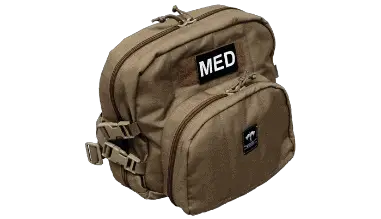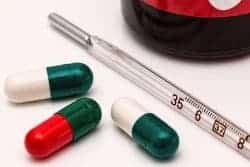
 Medical emergencies go far beyond straightforward fractures, sprains and breaks; would you know what to do in the case of an asthma attack, fever or dehydration? These things can happen to anyone and at any time, and when they do strike you might find yourself far away from emergency medical care. Then what?
Medical emergencies go far beyond straightforward fractures, sprains and breaks; would you know what to do in the case of an asthma attack, fever or dehydration? These things can happen to anyone and at any time, and when they do strike you might find yourself far away from emergency medical care. Then what?
By Alex Coyne, a contributing author of SurvivalCache and SHTFBlog.com
Here are some common (and not so common) medical emergencies you should be prepared for and what to do…
#1: An asthma attack.
Chronic asthma sufferers should always have their medication on hand or within reach, especially when they plan on travelling. When they don’t, the first step is to keep the person calm and breathing deeply. Panic only causes the airways to close up further. Caffeinated beverages – coffee and energy drinks – are good in an emergency and can stop an asthma attack in its tracks; they’re always part of the emergency kit for good reason.
#2: Handling a fever.
 A fever is the body’s way of altering its temperature to kill any pathogens in the body. Symptoms include shivering, sweating and the sensation of feeling hot or cold – sometimes both interchangeably. The worst thing you can possibly do with someone who has a fever is to throw them into an ice bath. Yes, it’s one of those things you saw in the movies that can kill someone. A fever puts way too much strain on the heart, and your best bet for cooling down someone with a fever is to keep them hydrated, cool them down slowly with a cold cloth and try medication like paracetamol before seeking medical attention.
A fever is the body’s way of altering its temperature to kill any pathogens in the body. Symptoms include shivering, sweating and the sensation of feeling hot or cold – sometimes both interchangeably. The worst thing you can possibly do with someone who has a fever is to throw them into an ice bath. Yes, it’s one of those things you saw in the movies that can kill someone. A fever puts way too much strain on the heart, and your best bet for cooling down someone with a fever is to keep them hydrated, cool them down slowly with a cold cloth and try medication like paracetamol before seeking medical attention.
#3: Seeing (and stopping) advanced hypothermia.
Hypothermia is what happens when the body’s core temperature drops below 35°C; frostbite and hypothermia go hand in hand. The symptoms of hypothermia starts with shivering, then goes on to worse symptoms like drowsiness and confusion, which eventually leads to coma and death. With hypothermia, do not resort to alcohol or quickly warming the person: Both will do more damage. Remove the person from the cold environment, get them into dry, warm clothes and warm them up slowly.
#5: Dehydration.
 By the time your body tells you you’re thirsty, you’re already dehydrated: It pays to remember this fact on a daily basis and when camping or hiking. Make sure you drink plenty of (clean) water. Replace the fluid your body puts out (through sweat, for example) and then some more. Also pack drinks specifically for treating dehydration, which contain much-needed salts and electrolytes. In an emergency, a mixture of water, sugar and salt replaces the most necessary minerals. Remember that sugar, salt and alcohol all have dehydrating effects on the body.
By the time your body tells you you’re thirsty, you’re already dehydrated: It pays to remember this fact on a daily basis and when camping or hiking. Make sure you drink plenty of (clean) water. Replace the fluid your body puts out (through sweat, for example) and then some more. Also pack drinks specifically for treating dehydration, which contain much-needed salts and electrolytes. In an emergency, a mixture of water, sugar and salt replaces the most necessary minerals. Remember that sugar, salt and alcohol all have dehydrating effects on the body.
Keep in mind that coconut water, intravenously, will also replace electrolytes.
#6: How to stop bleeding.
Maybe it’s a small cut, or maybe the emergency is a little more severe – and spurting blood. You’ll encounter both in your lifetime, and it’s vital that you know how to handle it. For severe bleeding, apply firm pressure with a compress. Remember to wear gloves, and do not use a tourniquet. This cuts off blood circulation and will lead to tissue damage pretty quickly. For slight bleeding, both salt and sugar have antibacterial properties and will help the blood to clot sooner.
#7: Slowing an infection.
The biggest danger with most wounds, even small ones, is often not the wound itself but the resulting infection that can occur. When an injury occurs, the first priority after stopping the bleeding should be cleaning the wound with sterilized water or alcohol – trace amounts of dirt can be enough to cause a serious infection and should be removed. Sugar and salt, as mentioned above, have fantastic antibacterial properties. Yes, this will hurt, but what would you rather have in this situation?
If severe infection has already set in and medical help is not available for a long time (say, if you are stranded on a boat in the middle of the ocean), learn to look upon maggots as a good sign: They clean dead and infected skin out of the wounds, and should be allowed to do their thing before being removed – carefully, of course.
#8: Demystifying fainting spells.
The technical term for fainting, if you’ve ever wondered, is syncope. It can happen for a variety of reasons, including (but not limited to) blood pressure or lack of oxygen to the brain. Fainting at the site of blood we now know is a neurological condition. It’s never anything less than a medical emergency, and should always be treated with care – and examined on a case-by-case basis. First, check if the person is breathing and their heart is beating the way it should. Make sure that their airways are not obstructed and that they are away from danger. Then, try to revive them. Fluids – sugar water or fruit juice – should be given immediately.
#9: Spotting a stroke.
The cause of most strokes are a lack of blood supply to the brain.
 The symptoms of a stroke are varied and can include the feeling of pins and needles, fatigue, a loss of balance, paralysis – especially on one side of the body, double vision and difficulty speaking or slurred speech. Look for signs of confusion, and ask the patient to lift their arms above their head or touch their tongue to the roof of their mouth: If they can’t, you might be dealing with the symptoms of a stroke.
The symptoms of a stroke are varied and can include the feeling of pins and needles, fatigue, a loss of balance, paralysis – especially on one side of the body, double vision and difficulty speaking or slurred speech. Look for signs of confusion, and ask the patient to lift their arms above their head or touch their tongue to the roof of their mouth: If they can’t, you might be dealing with the symptoms of a stroke.
Like most other emergencies, keep the patient calm and stay calm yourself. Check their responses by asking some simple questions and seeing how they respond to physical stimuli. (Someone who has just had a stroke might be unconscious. In this case, resort to checking eyelid response.) If they are unconscious, you want to check their airways and heart rate and administer CPR before seeking help.
It is not recommended to give someone having a stroke something to eat or drink.
Share your medical emergency tips or stories with our readers in the comments.
Visit Sponsors of SurvivalCache.com
from SurvivalCache http://survivalcache.com/handling-medical-emergencies/


No comments:
Post a Comment